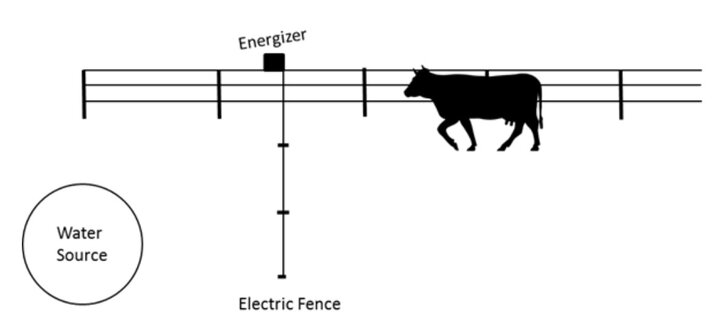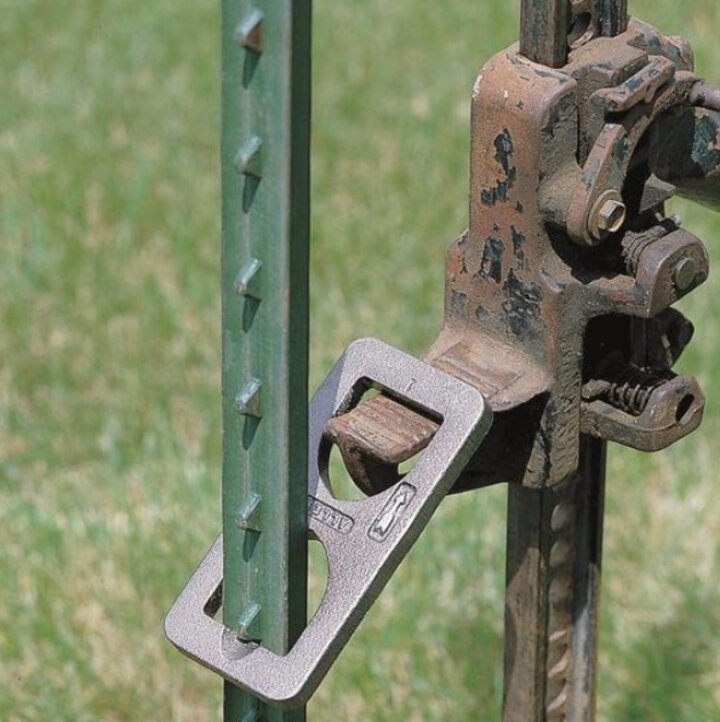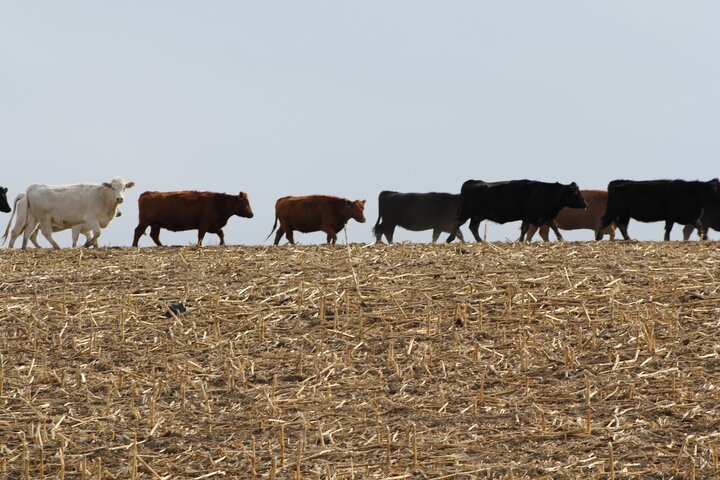Grazing crop residues is a great way to reduce winter feed costs. However, producers may run into one major issue with crop land – how does one keep cattle contained especially if the fence is only to be temporary? High-tensile wire electric fence is one solution to this problem. High-tensile electric fence is simple and easy to both install and remove. It is relatively low cost, moveable, and can be reused from year to year. There are several different options for producers to consider when building temporary electric fence. This article outlines some of these questions and supplies information to assist producers in their decision making process.
What to use as corner posts?
Wood posts or steel T-posts both work well as corner posts. Wood corner posts are more expensive ($9.29-$12.20) and are not easily removed, but they will make the fence more sturdy and easier to put up and take down each year (as the corner posts would remain and only the line posts and wire would be removed). However, that would require leaving the posts up in the field year-round. This potentially presents an inconvenience to the crop producer farming the field that may outweigh the benefits of not having to reinstall the posts each year. Steel T-posts are a less expensive option, can be removed relatively easily, and allow for the complete fence to be removed at the end of the grazing period for that field. Steel T-posts do require the use of insulators. Common insulators for corner T-posts include donut or strain, these insulators separate the high-tensile wire from the T-post, while attaching to the T-post with another piece of wire.

What about line fence posts?
A 5/16" line metal rod posts are a cheap option for fence posts for temporary fences. Space the posts about 40 feet apart with insulators on the inside of the field. This allows the wire to be in the inside of the field, keeping cattle from rubbing against the posts. In areas close to a busy road or high-traffic wildlife, place the posts closer together, as close as 20 feet apart. This keeps slack out of the wire and helps deter the livestock or wildlife away from the fence.

What gauge of high tensile wire is best?
When considering the type of wire to use, you need to consider the length of the fence you are building and the size of the cattle. The thinner wire is easier to handle and work with, but if covering a longer distance, a slightly thicker wire might be better. A 12.5 gauge (thicker) wire has much less voltage drop and can carry more electricity than a thinner wire, where 14 gauge wire (thinner) is easier to work with, but doesn't have the ability withstand the same amount of pressure from livestock as the 12.5 gauge.
How many strands of wire should I put up? And at what height?
Although a single strand of high-tensile wire is typically enough, a second, lower, electrified strand can easily be added along high-traffic roads or if small and large animals are grazing at the same time (for instance cow/calf pairs). Putting this second strand on a separate energizer is another idea for additional security. Wire height should be around 30 inches (2 ½ feet), and slightly lower if the electric fencing will be used for calves as well. If the wire is too high, the cattle will try to graze under it. If cattle touch the fence on the back of the neck when grazing under, they usually move forward, and tear down/go under the fence. A single wire at the right height is likely to cause them to back up when they come in contact with the fence.
How do I select an energizer? What factors can impact the amount of energy my fence needs?
Joules are the most common way to compare fence energizers. The number of joules needed for your fencing system depends on the length of the fence, the number of electrified wires, and the severity of conditions, such as vegetation matter, affecting the fence. Allowing one mile of fence per joule output is satisfactory in most situations. When choosing an energizer, look at the stored energy figure. Some energizers will advertise on stored and some on output, so be careful to read the energizer before purchasing. The higher the stored energy figure the more powerful the energizer. The stored energy is constant and not affected by external conditions, like poor grounding, so it is the most accurate measure of an energizer's capability.
Energizers are advertised in miles/acres. This is a suggestion for clean, single strand fence in perfect conditions. This means an energizer electrifying a 2-strand wire fence that is a mile around, with both strands electrified, is charging two miles of wire. Therefore, the energizer needs to have twice the energizer capacity than an energizer charging the same size field that only has one strand.
Is a solar, battery, or AC powered energizer better?
The power sources for energizers include AC, battery, and solar. AC energizers generally cost less than battery or solar for comparable stored energy, have a more consistent output of electricity, and are the preferred chargers if main power is available. Battery powered energizers not only cost more than those powered by AC, but also require the purchase of a battery that must be replaced periodically. However, battery powered energizers are an alternative when a direct electricity connection is not available for AC energizers.
When choosing the battery, a rechargeable battery that withstands regular charge and discharge cycles without damage is recommended. Marine or deep cycle type batteries with a voltage regulator that can start a battery at a low charge are preferred over automotive batteries. Automotive batteries are designed to supply very high current for only a short time, are not designed to be totally discharged, and will only re-charge up to about 60-70% of their original capacity.
Solar powered energizers generally are the most expensive. Solar units also require the purchase of a battery, but the replacement period is longer, and most solar units come with a built in battery. They are practical in areas where there is no main power and it's not easy to replace batteries frequently. Solar units work by charging a deep cycle battery when it converts light directly into energy. This energy is stored in the battery powered energizer, allowing it to operate during periods of low sunlight and at night. One downside to the solar unit in some areas during winter grazing is that the sunlight is not as frequent or as strong, leaving less time to store electricity for use during the low sunlight time. This could result in a fence with a lower charge and the energizer could need replaced with one that is fully charged more often. In times of snow cover, the snow will need removed from the solar panel to allow the energizer to utilize the light.
Does temporary fence still need ground rods?
To complete the electric circuit for the electric fence, ground rods need installed and connected to the energizer. It is important for the electric fence to be properly grounded, as improper grounding is a major cause of both energizer failure and the fence not producing a strong enough current to keep the cattle in the field. A fence cannot be over-grounded. A 3 foot long rod is usually sufficient for about two miles of temporary fencing. Additional ground rods would be needed for each additional 2 miles of fence. Dry soil is a poor conductor of electricity therefore when the soil is dry additional ground rods may be needed. A 3 foot T-handle ground rod is easier to remove when used with temporary fencing than most ground rods. Copper ground rods are not recommended since copper will react with any galvanized steel through electrolysis, and corrode the connection. Instead, choose galvanized steel grounding rods.
It's advised to spend a few extra dollars to ensure a proper grounding system. In some situations, it's worth utilizing a 2-wire fence for this reason. The second wire could be for grounding purposes, helping in the winter when the ground is dry or frozen, and ensures that the fence is more reliable and secure. The top wire is connected to the hot terminal on the energizer and the second, or bottom, wire is connected to the ground terminal and ground rods. This allows the current to flow back to the energizer through a wire that is better at conducting than dry or frozen soil.
Will my cattle respect the fence, or do they need to be trained?
If cattle are not familiar with electric fence, or hot wire, they will need to be trained to respect the fence. Build an effective fence that is well grounded and utilizes a strong enough energizer from the start will be beneficial for training. One way to train cattle to electric wire is, in a smaller pasture, with a non-electric perimeter fence, build a strong, short section of electric fence, using T-posts instead of rod posts, between the pasture fence and water source. The T-posts will be able to withstand more force than rod posts as the cattle are learning what the fence is. Set your energizer on the outside of the pasture fence, attach it to the electric fence, and extend the electric fence into the pasture such that there is only about a 15-20 foot gap from the perimeter fence on the other side of the pasture. The cattle will walk by or around the electric fence on their way to the water and learn to respect it. Check the fence a couple times a day, as it will be knocked off the posts from the cattle. The cattle will be trained in about a week. For calves, a second, lower hot wire helps train them. After a couple weeks, the bottom wire can be turned to a ground or cold wire, as by then the calves have learned.

What is the best way to set fence up?
When putting fence up, it is recommended to put in the corner posts first, string the wire from corner post to corner post, and follow with the rod posts. By stringing the wire before putting in the rod posts, the wire can be used as a guideline on where to put the rod posts for a straight fence. Angling the corner posts toward the outside can help to provide tension when the wire is pulled tight.

What is the best way to remove the fence?
To remove or pick up the electric fence, disconnect the fence from the power source, then un-hook the wire from the insulators. It is then easiest to remove the posts and followed by winding up the wire.
Using a fence winder, the wire can be rolled up to be stored until needed again. The options for fence winders are vast, ranging from hand winders, attachments on tractors, and electric or gas powered winders. Select the type best suited for your situation, taking into consideration the frequency it would be used, the length of the wire that will be rolled up, and the price of the winders.
Along with winding the electric fence up, the posts will need pulled from the ground as well. The rod posts pull out of the ground fairly easy. If the ground is frozen, pliers or vise-grips can help. If T-posts are used for corners and through-out the fence, they will require more force to remove from the ground. A T-post puller can make the job easier and will cost about $40 at a farm supply store.


